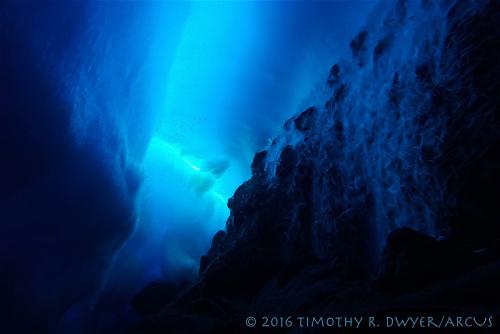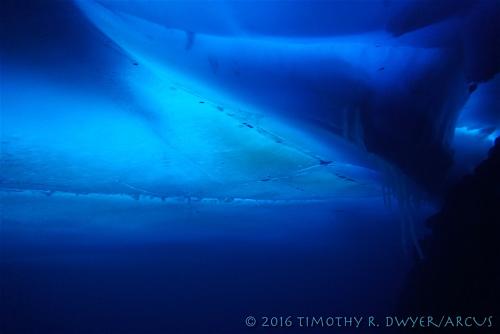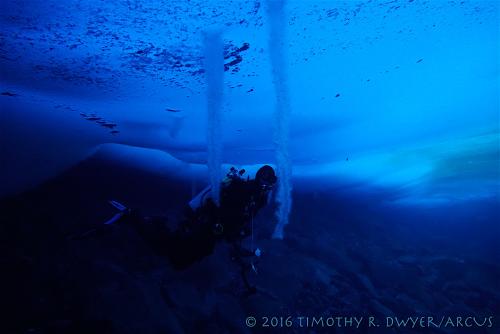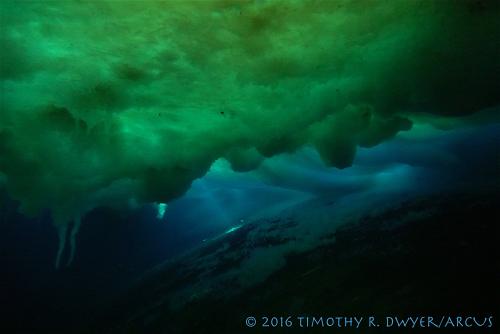
The folds and cracks in the sea ice formed by the lateral compression of the ice floes can be breathtaking and dangerous, but what is visible on the surface of pressure ridges is only part the story. Beneath the ice, the underside of a pressure ridge has many of the same features, plus a few extras that reveal more about the processes causing their formation. Unobscured by snow, the folding ice floe has the appearance of rolling waves locked in space. In fact, the technical term for the underside of a pressure ridge is the "keel," probably because they resemble a ship's keel when viewed from the right vantage point. Where the waves are steep, tunnels form between the keels and the shoreline, and the thin points in the ridges provide Weddell seals easier access to the ocean.
 The underside of pressure ridges form features called "keels."
The underside of pressure ridges form features called "keels."
One of the features of the pressure ridges not visible from the surface are the brine channels that form along low points in the keels. During sea ice formation in winter and early spring, the growing ice crystals exclude the salt dissolved in the liquid sea water. The excluded salt is concentrated into as-yet-unfrozen water, increasing the salt content and lowering the freezing point of the now super saline water. Microscopic channels of this solution - called "brine" - infiltrate the ice crystals but never fully freeze themselves. As the ice is thrust upward into ridges, gravity draws the supercooled brine downward until the dense, salty solution spills into the seawater beneath. The brine is so cold that it freezes the ocean water on contact, forming a hollow tube called a brine channel, or alternatively, a "brinicle," because of its icicle-like appearance.
 Dr. Bret Tobalske swims among "brinicles," hollow tubes of ice formed by super-cooled liquid pouring into the ocean.
Dr. Bret Tobalske swims among "brinicles," hollow tubes of ice formed by super-cooled liquid pouring into the ocean.
Swimming among the tunnels, brinicles, and small caverns that form where the sea ice comes ashore is truly otherworldly. Waterfalls of anchor ice cascade down the black volcanic rock, trapping urchins and sea stars in geometric prisons. Fiberoptically-lit surface cracks run the lengths of the pressure ridge peaks, adding architectural accents to the curves and fissures of a crystalline cave system. Our exhaled bubbles run chaotically across the under surface, collecting in inverted pools of reflective air. Where seals maintain an access hole, sun beams spotlight specific sections of the ocean floor below. The seals themselves keep up a constant chorus of chirps and zaps as they cruise through the buckled ice, disappearing down unseen avenues known only to them. If I weren't limited by my own tolerance for cold and my dwindling air supply, I would stay here for hours, swimming and exploring.
 A light leak from a hole in the pressure ridge highlights the seafloor below.
A light leak from a hole in the pressure ridge highlights the seafloor below.

Comments